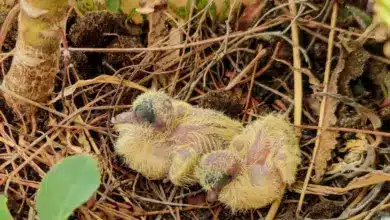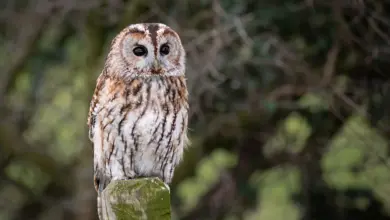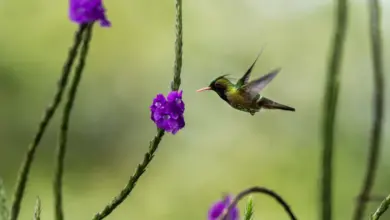Hummingbirds California – Species Identification Guide
In this article, we cover the 14 major types of hummingbirds California residents can spot.
For bird watchers, hummingbirds are one of the most fascinating species. Apart from their beautiful appearance and their tiny size, their ability to fly backward and hover in mid-air are other amazing aspects of this bird.
California is one of the biggest hotspots in the world for sighting hummingbirds and hosts one of the highest numbers of these birds.
Most male hummingbirds sighted in California have gorgets (flashy throat patches). Females and young birds don’t have any throat patches and have duller, greenish-grey plumage.



This is, of course, with the exception of the female Allen’s and Rufous Hummingbirds – which have a coppery-orange color.
We cover information about color, sexing, migration, the best times to see, and more about the 14 types of Californian hummingbirds in this article.
We have divided the article into native and non-native hummingbirds for your convenience. Let’s start with the ones that live in California all year round.
Hummingbirds … Hummingbirds found in the USA (by U.S. State) … Canada … Mexico … Puerto Rico … Jamaica … Honduras
Hummingbird Information … Hummingbird Species Photo Gallery
Native hummingbirds
1. Anna’s hummingbird (Calypte anna)
This is the most common hummingbird species in California. They are named after Duchess Anna Massena of Rivoli.
They’re one of the few native hummingbirds in the state, found all year round. With a length ranging from 3.9 inches to 4.5 inches, Anna’s Hummingbird is a slightly larger species of hummingbird.
The males feature dark rose-red crowns and throats with a glossy finish. In low light conditions, it often appears dark purple or black.
Their back is a shade of metallic green, while the underside is grayish.
They are very territorial and frequently dive in front of other birds and even people when they feel threatened, using their tails to make high-pitched popping sounds.
The females also have greenish backs, but the crest is light gray, and the throat is spotted with white and red dots.
Anna’s hummingbird is also one of the most vocal hummingbird species you’d find in the United States and is the only one here to produce songs.
The song of Anna’s hummingbird consists of “chip” vocalizations – a scratchy and toneless sound produced when they move from flower to flower.
The remaining hummingbird species in the US are mostly silent.
Although Anna’s hummingbirds resemble Costa’s Hummingbirds, the males of the former species have longer throat feathers.
These hummingbirds are larger than Rufous hummingbirds and lack the latter’s rusty coloration.

2. Allen’s Hummingbird (Selasphorus sasin)
The Allen’s hummingbird used to be a native breed that nested in coastal California and migrated to Mexico in winter.
However, they’re increasingly becoming year-round residents in the state. Even when they migrate, they do it only to the Eastern US, not Mexico.
Male Allen’s hummingbirds have bright green backs and rufous rumps and tail feathers. The color of the throat ranges from orangish-red to yellowish-orange, and the tips of the tail feathers are black.
While females also have similar coloration, their gorget lacks the iridescence found in males.
It’s easy to confuse Allen’s hummingbirds and Rufous hummingbirds for one another, but the latter has a coppery back rather than a green one.

3. Calliope Hummingbird – (Selasphorus calliope)
Calliope Hummingbirds are the smallest birds you’ll find in North America. Like Allen’s hummingbird, they’re native breeders in California.
They migrate to the east or south during the winter. In spring, you’ll find these hummingbirds in northern California, the northwestern states, and Canada.
The males have dark tails, while the backs and the flanks are a glossy green shade. They’re white underneath and are characterized by bright magenta throats with an iridescent effect.
The females, on the other hand, lack this iridescence and a pinkish-white color underneath.
Despite growing only to a size of 3.1-3.5 inches, these birds are very territorial and aggressive. They’re known to be able to chase away even birds of prey like red-tailed hawks.

Seasonal Hummingbirds
4. Rufous Hummingbird (Selasphorus rufus)
This is another aggressive species of hummingbird, known to chase away larger birds and rodents from food sources.
The Rufous Hummingbird stays in Central America and Mexico during winter and moves to California to breed in April.
You’ll usually find them in flowering gardens and around nectar feeders.
Gender identification isn’t hard when it comes to the Rufous Hummingbirds in California, as the males have prominent glossy orange-red dots.
The females are characterized by rufous white-tipped tail feathers, green crowns and backs, and white patches on the throats.

5. Costa’s Hummingbird (Calypte costae)
Interestingly, some of these hummingbirds live in California throughout the year, while the rest migrate seasonally.
Costa’s Hummingbird is one of the most common southern California hummingbirds and is especially abundant between the San Diegan district and Ventura County.
They’re also found in Mohave Deserts and Colorado, while stragglers sometimes end up as far as Oakland.
Stretching across western and southern California, San Joaquin Valley is their most popular breeding ground.
The year-round natives usually overwinter in the deserts and the coasts in the south. Most of them live near the Los Angeles County foothills.
You can find these hummingbirds in palm springs throughout the year too.
While they’re also common in parks and other natural areas in Orange County in the summer, you won’t find many of them here in winter.
In the xeric chaparral and the dry coastal sage scrub of Monterey County, they are rare and local residents.
The females are identifiable by their greyish-green crowns and buffy-colored sides. Apart from the black spots around the throat, the chin and the plumage under it are whitish.
Although mostly dark, the tail has white-tipped outer feathers. The males, on the other hand, have glossy, purple crowns that are hard to miss.
They feature a metallic green back and prominent throat feathers that carry a mustache-like appearance.
Although these hummingbirds look similar to the male Anna’s Hummingbird, the latter has longer throat feathers.

6. Green-violetears Hummingbird (Colibri thalassinus)
Also known as Mexican violetear, the green violetear is a migratory hummingbird species in California and is quite rare in this state.
Mostly common in Central America and Mexico, they have also been spotted in several parts of the US, especially Texas.
You may sight them once in a while during the hummingbird season in California, but the chances are very low.
These beautiful hummingbirds are a rich shade of emerald green with an iridescent purple patch across the cheek. The wings are a dark shade that contrasts the other colors well.

7. Violet-crowned Hummingbirds (Amazilia voliceps)
The violet-crowned hummingbird gets its name from its iridescent bluish-violet crown. Their white under plumage is another one of the identifying features, and they have an emerald green back.
The color of the tail ranges from olive green to dark brown, and the straight reddish/orangey has a black tip.
Although the females and the juveniles of this species look similar to the males, their crown is lighter and greener. Besides, they also have less colorful plumage than the males.
This species of hummingbird is rather rare in California – they mostly stay in Mexico and some parts of the US (southwest to south-central).
Stragglers sometimes end up as far as Texas in the Southwest and California in the southernmost, outside of the breeding season.

8. Black-chinned Hummingbirds (Archilochus alexandri)
This black hummingbird in California is the smallest hummingbird you’ll find in the state. The males have black, shimmering throats with purple edges and pale feathers that form a collar-like pattern.
Depending on the lighting condition, the head might appear to be entirely black. Their backs are green, and green feathers cover the chest area.
The females also have green backs, but they are pale underneath and sometimes have speckles on the throat.
They spend the winter months in Mexico and migrate to California and other western states of the US in spring and summer.

9. Xantus’s Hummingbirds (Basilinna xantusii)
This is yet another Mexican hummingbird that you can find in California. Named after Hungarian zoologist John Xantus de Vesey, these birds are native to Baja California.
However, they sometimes end up in Southern California as vagrants when they wander away from their usual breeding grounds.
These birds also travel up to British Columbia in Canada, along the Pacific Coast of North America. Several sightings report breeding activities among the Xantus’s Hummingbirds spotted in California.
The males have black-tipped red bills and green throats, while the females are characterized by brownish throats and blackish bills.
Both genders have green upper plumage, white and black eye stripes, dark and straight tails, and cinnamon brown underneath.

10. Blue-throated Hummingbirds (Lampornis clemenciae)
The blue-throated hummingbird is one of the largest species of hummingbirds native to California.
While they have a preference for nectar with high sugar content like any other hummingbird species, their diet is also heavily insectivorous.
These mountainous birds display an interesting behavior – they return to the same nesting spot every year and stack a new nest over the previous one.
Eventually, this results in a tall tower-like structure.
The males are characterized by an iridescent blue gorget, which explains the name. In females and juveniles, this region is grey rather than blue.
The blue patch in the males may appear black or grey in low-light conditions.

11. Rivoli’s Hummingbird (Eugenes fulgens)
Named to honor Francois Victor Massena, the Duke of Rivoli, this Rivoli’s hummingbird has undergone several name changes.
This species was previously known as the Magnificent Hummingbird and Refulgent Hummingbird and is very rare in California.
With a heart rate ranging between 420 and 1200 beats, this hummingbird has the fastest beating heart among all living invertebrate species.
Although quite colorful and magnificent, these hummingbirds appear rather dark unless you’re looking at them in bright daylight.
The males feature dark green backs, metallic green throats, black chests, and purple foreheads and crowns. Like in the case of most hummingbird species, the plumage is less bright in the females.
They have olive green crowns and backs, grey chests, and pearl-grey tipped tail feathers.
These birds mostly live in Mexico, with their preferred habitats being mountainous forests and shady canyons.

12. Ruby-throated Hummingbird (Archilochus colubris)
If you notice a red-throated hummingbird in California that’s similar to the Rufous Hummingbird but smaller in size, it might be a Ruby-throated Hummingbird.
Although the males of both species have red throats, the shade is different. Rufous hummingbirds have orange-red throats, while the throat of the Ruby-throated Hummingbird is ruby red.
The former also has a pointed tail, while the latter features a forked tail. As for the females, ruby-throated hummingbirds lack the green feathers that cover the back and the crown of female rufous hummingbirds.
Gender identification of the ruby-throated hummingbird is easy. The males have emerald green backs and white collars, while the females have green backs and tail feathers banded with black, white, and grey-green.

13. Broad-tailed Hummingbird (Selsaphoris platycercus)
This migratory species of California hummingbirds nest in the meadows and the mountain forests of Central California.
They move to Mexico, El Salvador, and sometimes Guatemala in the South during the winter and pass through Eastern California during their migrations.
This is another red-throated hummingbird in California, though the throat patch is iridescent rose-red in this species and is present only in males.
An interesting characteristic of the male broad-tailed hummingbird is the whistling noise made by its rounded tail while flying.
They’re also identifiable by their metallic green back and white chest feathers. The females lack not only the throat patch but also have different tail colors.
The outer tail feathers are rust-colored with white tips, while the ones in the Centre vary from green to blackish.

14. Broad-billed hummingbird (Cynanthus latirostris)
The Broad-billed hummingbird is a Mexican species that frequents the southern parts of the US but is quite rare in California.
In this species, the males have deep blue throats and glossy, clean plumage on and above the chest. Their dark tails are slightly forked and have white under-tail feathers.
The females aren’t as colorful, and the color of the throat, chest, and belly ranges from light to medium grey. They’re also distinguished by the white stripe they have over each eye.

The Hummingbird Moth: Is It A Hummingbird or a Moth?
The hawk moth, also known as the hummingbird moth, is often mistaken for a species of hummingbird.
However, it’s not even a bird – it’s an insect.
This moth is named after hummingbirds because they share the unique feeding and flight pattern found in the latter.
Like hummingbirds, they feed on nectar from flowers while hovering in midair. You can differentiate the moths from the birds by the antennae at the top of their heads.

Where To See Hummingbirds in California?
Hummingbirds are found throughout California, though you won’t find the same species in every part of the state.
These birds are especially common in the San Francisco Bay Area, the University of California Arboretum Botanic Garden, and Cabrillo National Monument. Especially if you’re looking for native species, these are the areas you should visit.
Do Hummingbirds Hibernate in The Winter In California?
As mentioned in many of the birds above, most species of hummingbirds do not stay in California during winter.
The ones that do stay don’t hibernate throughout the winter.
Instead, they enter a state of reduced metabolism called torpor at night. Similar to hibernation, it helps them survive cold temperatures in the absence of adequate food sources.
How To Attract Hummingbirds To Your Garden?
To attract any species of birds to your garden, you need to lure them by providing suitable food sources. Here are a few ways how you can get more hummingbirds to visit your garden.
1. Planting native flowers
You can attract hummingbirds to your garden naturally by planting native blossoms. Bright and tubular flowers are especially good at attracting these tiny birds as they produce the most nectar.
Red flowers are the preferred choice for most hummingbirds, but many love orange, pink, and even purple blossoms.
Coral honeysuckle, Red Larkspur, California Fuchsia, and Western Columbine plants are great for attracting hummingbirds.
If you need hummingbird-feeding plants for planting baskets, go for California Indian Pink, Salvia Celestial Blue or Purple Sage, Nasturtium, or begonia.

2. Hanging a hummingbird feeder
A hummingbird feeder isn’t the same as your typical bird feeder. Rather than grains, it holds nectar for the hummingbirds to drink.
As you know, a hummingbird’s diet primarily comprises nectar, and they drink it in large quantities. Most hummingbird feeders are red and have floral patterns to attract them, but there are several designs to choose from.
You may buy artificial nectar, but it’s better to make it at home using some sugar and water.

3. Letting insects be
Hummingbirds can’t survive solely on nectar – they also need protein.
If you have insects like spiders, mosquitoes, gnats, and fruit flies in your garden, they will help you attract hummingbirds.
Make sure not to use pesticides in your garden (unless you start getting an infestation). This will help maintain a natural ecological balance and bring these beautiful birds to you.
4. Providing water
As with any other bird species, you need to provide a water source for the hummingbird to bathe in and drink from.
These tiny birds usually find conventional birdbaths to be too deep. You may either buy a hummingbird bath or come up with a DIY solution.
Frequently Asked Questions
1. Are hummingbirds common in California?
In fact, Anna’s, Allen’s, and Calliope hummingbirds are native here and can be seen throughout the year.
These species of California hummingbirds are more common than the rest. The others we have mentioned above are migratory.
2. Where do California hummingbirds go in the winter?
However, a majority of the hummingbirds seen in California migrate to warmer regions in Mexico and Central America during the cold months.
3. When should I put out my hummingbird feeder in California?
This is when they get more active at the onset of spring. The seasonal hummingbirds from Central America and Mexico visit California around this time too.
4. Are hummingbirds year-round in California?
However, this doesn’t apply to every hummingbird species sighted in this state. Most of them visit California during spring and summer and overwinter in Mexico and Central America.
5. Do hummingbirds return to the same feeders every year?
Hummingbirds are known for an exceptionally good memory, and many of them return to the same feeders every year.
Wrap up
With the huge variety of hummingbirds on display, California is a haven for bird lovers. Set up your hummingbird feeder during the breeding season this year and watch those beautiful visitors fly into your garden.
I’ve covered all the hummingbird species that you’re likely to come across in California. Hopefully, you’ll find this helpful and can identify the hummingbird species you spot.
Thank you for reading!
Note From Webmaster
If you see a hummingbird that doesn’t appear to be any of the above, please e-mail comments/images to: [email protected]. Thanks!




